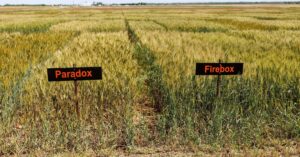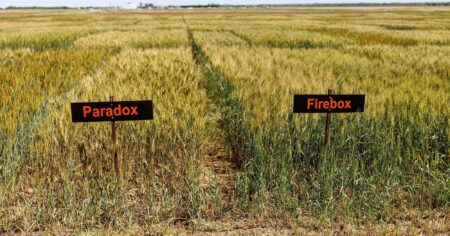The April World Agricultural Supply and Demand Estimates (WASDE) report showed corn carryout decreasing by 75 million bushels, soybean ending stocks decreasing by 5 million bushels, and wheat ending stocks increasing by 27 million bushels. Next week’s report will give the market its first glimpse of 2025/2026 production and demand estimates. Ahead of the new report, here is what farmers need to know about the corn, soybean, and wheat markets, and what Grain Market Insider will be looking for in the updated balance sheets.
Corn Market Expectations
In last month’s WASDE report, U.S. corn carryout was lowered from 1.54 billion bushels to 1.465 billion, after exports were increased by 100 million bushels and feed demand was reduced by 25 million bushels. World ending stocks were reduced from 288.94 million metric tons (mmt) in March to 287.65 mmt.
Since then, export demand has remained strong and continues to exceed the USDA’s projected pace for the 2024/2025 crop year. Total sales commitments are at 90.7% of the USDA’s current forecast for the crop year, compared to the five-year average of 88.3% by this point in the year. Export inspections are at 63.1% of the USDA’s current estimate compared to the five-year average of 54.3%. Ethanol production has slowed substantially in recent weeks and has remained close to the pace needed to meet the current projection for the crop year.
If the USDA adjusts demand in the May WASDE report, the agency could increase exports and possibly make a slight reduction in ethanol production. For the 2025/2026 crop, Grain Market Insider is expecting ending stocks near 2.15 billion bushels, based on the expectation that farmers will plant 95.3 million acres and assuming a trendline yield of 181 bushels per acre (bpa).
Soybean Market Outlook
U.S. ending stocks for 2024/2025 soybeans were reduced from 380 million bushels in March to 375 million in the April WASDE report, primarily due to higher crush. World ending stocks increased from 121.41 mmt to 122.47 mmt.
Since then, the export pace has remained firm and is slightly ahead of the pace needed to meet the current estimate for the 2024/2025 crop year. Soybean sales are at 95.5% of the USDA’s current projection for the crop year, compared to the five-year average of 93.3% by this point in the year. Inspections are running almost 4% ahead of the five-year average pace. Soybean crush for the month of March was a record at 206.57 million bushels, up from 203.54 million last year.
With exports and crush in line with current estimates, Grain Market Insider does not expect adjustments to old crop soybean ending stocks. For the 2025/2026 crop year, there is potential for ending stocks to come in anywhere from 290 million bushels to 400 million, depending on projected export demand. Farmers are expected to plant 83.5 million acres. At a yield of 52.5 bpa, total production would reach 4.34 billion bushels.
Considerations for the Wheat Market
The April report was once again bearish. U.S. ending stocks were increased from 819 million bushels to 846 million due to reduced exports. World ending stocks were also adjusted slightly higher, from 260.08 mmt to 260.70 mmt.
Export sales have remained firm since last month’s report. The current sales pace — 95.7% of USDA’s projection for the 2024/2025 crop year — is better than the five-year average of 94% by this point in the year. The current pace of inspections is at 87.2% of the current estimate, compared to the five-year average of 85%.
Grain Market Insider does not expect any adjustments to old crop ending stocks on the May report. New crop ending stocks should be near 850 million bushels, based on planted acres of 47 million and an average yield of 50.1 bpa.
Historical Patterns and Statistical Perspective
Based on data from 2000-2023, Grain Market Insider’s internal research indicates that volatility on the May WASDE report day tends to be moderate for corn, soybeans, and wheat.
For corn, the May report has a 50-50 chance of being positive or negative. In terms of outright volatility, this report ranks in the middle, with an average absolute change of 7¢. When examining upward or downward moves, the average positive net change on report day is 6¢, while the average negative net change is 9¢.
For soybeans, the May report also has a 50-50 chance of being positive or negative. The report is also in the middle of the range in regards to volatility. When the reaction is positive, the average bounce is 19¢, compared to an average decline of 11¢ if the reaction is negative.
For wheat, the May WASDE report has a 55% chance of triggering a negative reaction. Positive reactions generate an average gain of 5¢, which is the smallest change of all reports. Negative reactions, on average, trigger an 11¢ loss, which is among the largest moves.
Disclaimer: The data contained herein is believed to be drawn from reliable sources but cannot be guaranteed. Individuals acting on this information are responsible for their own actions. Commodity trading may not be suitable for all recipients of this report. Futures and options trading involves significant risk of loss and may not be suitable for everyone. Therefore, carefully consider whether such trading is suitable for you in light of your financial condition. Examples of seasonal price moves or extreme market conditions are not meant to imply that such moves or conditions are common occurrences or likely to occur. Futures prices have already factored in the seasonal aspects of supply and demand. No representation is being made that scenario planning, strategy, or discipline will guarantee success or profits. Any decisions you may make to buy, sell, or hold a futures or options position on such research are entirely your own and not in any way deemed to be endorsed by or attributed to Total Farm Marketing. Total Farm Marketing and TFM refer to Stewart-Peterson Group Inc., Stewart-Peterson Inc., and SP Risk Services LLC. Stewart-Peterson Group Inc. is registered with the Commodity Futures Trading Commission (CFTC) as an introducing broker and is a member of the National Futures Association. SP Risk Services, LLC is an insurance agency and an equal opportunity provider. Stewart-Peterson Inc. is a publishing company. A customer may have relationships with all three companies. SP Risk Services LLC and Stewart-Peterson Inc. are wholly owned by Stewart-Peterson Group Inc. unless otherwise noted, services referenced are services of Stewart-Peterson Group Inc. Presented for solicitation.
About Grain Market Insider: Amidst the intricacies of market analysis, staying informed is key. Grain Market Insider newsletter from Stewart-Peterson Inc. is your trusted source for grain market commentary and actionable advice, providing you with exclusive insights, timely updates, and expert commentary. Click here to learn more and subscribe to Grain Market Insider today for the confidence and security you need, and the data you can trust, for your grain marketing decisions.
About the Author: Eric Fransen is the Director of TFM360 Market Analytics at Total Farm Marketing. Eric’s calm, confident, and reasonable approach to farm marketing has been a safe harbor to his clients and the grain team alike since 2007, making him a welcome person to turn to in an often-unsettled market. Eric enjoys breaking down and explaining complex concepts and strategies to farmers as he helps them make decisions to help improve their bottom lines.



:max_bytes(150000):strip_icc()/diseaseplaybookcorntarspot-fb7ff9d7c32e4e63b3e5e97dbe406eeb.jpg)



:max_bytes(150000):strip_icc()/2208-05-044_corn-8740989afb284134bb9074978ef9a094.jpg)


:max_bytes(150000):strip_icc()/IMG_6780-a50022e918c94a9e8e8e517aa42ee9c8.jpeg)

:max_bytes(150000):strip_icc()/Between-Corn-Rows-POV-Deep-Natalina-Sents-Bausch-dca1b82edce44bdd97dda3b76312e719.jpg)